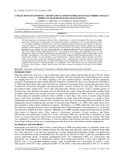Utilization Of Synthetic And Botanical Insecticides To Manage Thrips (thysan.: Thrip.) On Snap Beans (fabaceae) In Kenya

View/
Date
2010-01Author
Nderitu, J
Mwangi, F
Nyamasyo, G
Kasina, M
Type
ArticleLanguage
enMetadata
Show full item recordAbstract
This field experiment was performed in Mwea–Tebere, Central Kenya, to evaluate and compare effectiveness of synthetic insecticides (Thiacloprid and chloropyrifos) and botanical insecticides (azadirachtin 0.15% A.I. and azadirachtin 0.06% A.I.) to suppress populations of Frankliniella occidentalis Pergande and Megalurothrips sjostedti Trybom on snap beans (Phaseolus vulgaris L). The treatments were laid in complete randomized block design with four replicates for two relay plantings in 2006. Sampling was done by collecting flowers and pods from ten randomly selected plants per plot for thrips identification and counting. The results indicate that there was significant difference (P<0.05) among the four treatments. The lowest number of adult thrips and their larvae was recorded in plots treated with azadirachtin 0.15% A.I. and chloropyrifos. Snap beans treated with thiacloprid and azadirachtin 0.06 % A.I. had higher number of adult thrips in both plantings. Thiacloprid was only effective in control of M. sjostedti compared with the botanical pesticides. Orius spp, a natural enemy of thrips, was more abundant on neem based products compared with the synthetic pesticides. In terms of yields, snap bean plots treated with chloropyrifos produced more marketable pods compared with plots treated with botanical pesticides in both plantings. It is argued that farmers can use chloropyrifos early in the season to reduce thrips population but at fruiting it is recommended they use Azadirachtin 0.15%. This will lower the cost of production incurred by farmers, allow increase of thrips natural enemies and reduce resistance development by the pest to the synthetic pesticides.
URI
http://www.ggfagro.com/books/IJSCP/Volume%205%20Issue1%20January2010/IJSCP%20V5%20I1%281-4%29%20Kenya.pdfhttp://erepository.uonbi.ac.ke:8080/xmlui/handle/123456789/38557
Citation
Int. J. Sustain. Crop Prod. 5(1):1-4 (January 2010Publisher
University of Nairobi Department of Plant Science and Crop Protection, University of Nairobi School of Biological Sciences, University of Nairobi Entomology & Biotechnology, Kenya Agricultural Research Institute
